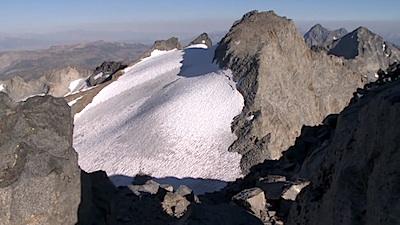Glaciers are not known for their speed, hence the phrase "glacial pace." That said, the largest glacier in Yosemite National Park has come to a halt, though a neighboring river of ice continues to flow downhill at about an inch a day, its historical rate.
According to observations by scientists from the National Park Service and the University of Colorado, the Lyell Glacier has stagnated, or ceased its downhill movement, while the adjacent Maclure Glacier is still moving at its historical rate, about one inch per day.
The following report was prepared by the park staff.
Glaciers created much of the scenery of Yosemite, including iconic features such as Half Dome. Glaciers are defined as long-lasting ice masses that arise from the accumulation of snow, and move downhill by flowing and sliding. A glacier's health is determined by the amount of winter snowfall compared to summertime melting of snow and ice. The movement of a glacier is primarily determined by the glacier's thickness and steepness. Because they are sensitive to environmental conditions, glaciers are important indicators of climate change.
Building on historical research conducted by John Muir and other notable individuals in Yosemite's history, the research team monitored the Lyell Glacier and the Maclure Glacier, deep in Yosemite's high-country. Movement of the glaciers was monitored by placing stakes in the ice and tracking their positions over a four year period.
Data collected from the stakes placed on the Lyell Glacier showed that no movement has occurred within the last several years. Earlier research on the glacier showed that it was moving in the 1930's. Stagnation has therefore occurred since that time, perhaps within the past decade. In addition, the Lyell Glacier has decreased in size by about 60% since 1900, and has thinned by approximately 120 vertical feet. This thinning of the glacier is most likely why the glacier has stopped moving.
"The Lyell Glacier has historically been recognized as the largest glacier in Yosemite National Park and the second largest in the Sierra Nevada," said Yosemite National Park Geologist Greg Stock, who co-led the investigation with Robert Anderson of the University of Colorado. "However, the lack of movement suggests that the term 'glacier' no longer accurately describes this feature."
The team also measured the Maclure Glacier, which is adjacent to the Lyell Glacier. John Muir first documented movement of this glacier in 1872. The research team mimicked Muir's measurements in 2012 by measuring stakes over the same period of the melt season. Despite a similar amount of ice loss as the Lyell Glacier, the team found that the Maclure Glacier continues to move at the same rate as that measured by Muir, about one inch per day. Although the Maclure Glacier has also thinned substantially, it is still thick enough to move and flow. Much of the downhill movement occurs by slow sliding at the glacier bed due to increased amounts of meltwater.
Research on the glaciers will continue to be conducted through collection of data on snowpack, temperature, and ice melting rates. Guided by records of the local climate archived in the widths of tree rings in nearby forests, the research team will also create a model to show the change in size of the glaciers over the past 300 years. This model will provide insight into the future health of these ice masses.
This work contributes to the growing evidence of ice loss worldwide. The differing behavior of the adjacent Lyell Glacier and Maclure Glacier illustrates the complexity of the landscape's response to climate change. However, the fact that both glaciers are shrinking - causing the Lyell Glacier to cease movement -highlights the impact that a changing climate is having in Yosemite National Park.
Funding for this research project was provided by the Yosemite Conservancy.


 Support Essential Coverage of Essential Places
Support Essential Coverage of Essential Places






